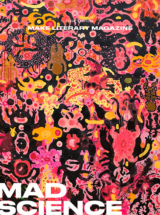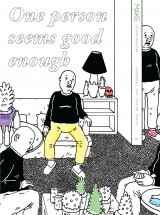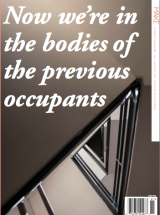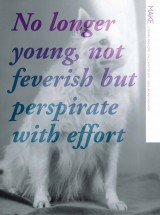
by Katherine Preston

Published by Polity Books, 2018 | 160 pages
“If a tree falls in the forest, and no one is around to hear it, does it make a sound?” We are all familiar with this common riddle, and how its possible answers demand that we make certain assumptions. If one answers “Yes, of course it makes a sound,” one assumes that worldly phenomena precede human perception: we don’t need to be around for things to “happen.” But if one answers “No,” humans are assumed to be central to experience, and human perception becomes the sun by which the planets of worldly phenomena must orbit. If, like a backseat detective, we pick at this riddle a bit more, not allowing it to oscillate only between a “yes” and “no” answer, we find that the question is premised on other assumptions: Where are we standing? How big is the tree? How good is the listener’s ear? How have we come to think of the forest as quiet or a silent space where a tree falling could even be heard? It is this last question—the forgotten silence of spaces, both inner and outer—that is the main concern of Alain Corbin’s new book A History of Silence: From the Renaissance to the Present Day (2018), and translated beautifully by Jean Birrel.
Readers may be familiar with Corbin’s earlier work in the history of the senses, which began with The Foul and the Fragrant: Odor and the French Social Imagination (1986). There, he pivots off of Michel Foucault’s famous focus on the sense of sight—the great “panoptic dream” of disciplinary societies—in order to historicize the forgotten olfactory. “What produced,” he asks, echoing Foucault, “the mysterious and alarming strategy of deodorization that causes us to be intolerant of everything that offends our muted olfactory environment?” In the field of sound studies, Corbin is most famous for Village Bells: Sound and Meaning in the 19th-Century French Countryside (1994), a sweeping history of post-revolutionary France from the angle of what he calls its “auditory landscape.” The book charts the rise of secular auditory signals, resuscitates long-forgotten auditory vocabulary, culls the archive of French history for disputes among bells, and even includes visual diagrams that map secular peals across France and convey the number of bells cast over the century.
Unlike these two works, A History of Silence is harder to categorize. Anyone looking for the kind of thorough historical investigation present in Corbin’s earlier work will be disappointed, for it isn’t your typical academic book with endless footnotes and a threaded historical or theoretical argument. Nor does it offer the sort of visionary experimentalism of John Cage’s Silence (1961), or the simple, nostalgic, coffee-table-book-wisdom of Erling Kagge’s Silence: In the Age of Noise (2017). Corbin’s A History of Silence is more like a common-place book – a scrapbook used for recording notes, poems, and observations—chock-full of delectable quotations about silence from French laureates both familiar (Proust, Hugo, and Valery) and less familiar (Belgian poet Georges Rodenbach, Swiss writer Max Picard, and French novelist Joris-Karl Huysmans) to American ears. Because it includes many examples of art criticism, the book would also serve as a fine companion to a stroll through the paintings of, say, the Musée d’Orsay. On Edgar Degas’ L’ Absinthe, Corbin writes: “Though sitting side by side, the two people seem to be strangers to each other. One is plunged into an interior silence, the other remains silent, but still watches the world go by.” Featuring a full page, black and white version of the painting, Corbin’s focus on the visual translation of the inaudible calls attention to silences previously unheard. We might do better to think of Enda Duffy’s work on speed and thus consider Corbin’s latest work a sort of silence “handbook.”
Part of the difficulty of parsing A History of Silence is that its most basic dichotomous structure and its most important theoretical contribution are hidden behind a wandering prose style. Corbin tells us from early on, unapologetically, that his survey will cover a specific history of the “West”, and strings of quotations and cursory interpretations of the aforementioned canonical Western artists, both visual and literary, are split across nine chapters. Each chapter is separated by the different contexts and texts in which silence is associated—domestic interiors, nature, painting, prayer, bodily postures, the Bible, human speech, and human relationships. The book is constantly shifting in and out these texts and contexts, so Corbin often resorts to a kind of metadiscourse (“Let us now return” or “We now come to the place”) in an attempt to guide us through these myriad surface readings. The book’s most sturdy structure, though, lies upon the opposition between the interior spaces of silence (how silence aided meditation and inner reflection) and the exterior spaces of silence (whether it be between two people, or between a person and an architectural space). There are fascinating insights into how in the Renaissance, silence became a “precondition for prayer,” the kindling for lighting a spiritual “inner fire,” and a necessity of “good manners;” but it is in his focus on the examples of how silence interacts with society, or what he calls the “tactics of silence,” that Corbin’s critical voice emerges most clearly.
For Corbin, “silence” became a key rhetorical trope for people, especially colonizers, to map their affective and political dispositions onto “silent spaces.” Thus, the silence of the ruins of Palmyra in Syria are an “abode of silence” for French romantic François-René de Chateaubriand yet the “most violent silence” for Swiss writer Max Picard. In juxtaposing these responses Corbin suggests that descriptions about silence tell us more about the describers than anything about silence per se, that they index the constant changing “social value” that silence assumes. A History of Silence might seem out of tune with most recent publications in the field of sound studies, which have doubled down on both exploring conceptions of difference across the identity markers of race, class, and gender, as well as refocusing the field beyond a strictly “Western” purview. But despite its “old-guarde” style, it echoes some of the most powerful claims of these new works. Jennifer Stoever-Ackerman’s influential work, for example, has helped us better understand that noise is less the opposite of sound and more “a shifting analytic that renders certain sounds—and the bodies that produce and consume them—as Other.” Corbin’s first sentence is to remind us that “Silence is not simply the absence of noise,” but his insights throughout the book repeatedly suggest that “silence” does share with noise this ability to be mobilized as, again echoing Foucault, “an instrument of power.”
Still, there are a few troubling silences to Corbin’s narrative. At times Corbin will pause us at a terminological distinction, as when he comes across in Proust a “profound and total silence—we should reflect on this distinction.” But though the word “profound” is repeated throughout the book, there is no reflection on such distinctions. There are also some historical ellipses, as when he wonders about the origins of the “moment of silence” without any sort of historical inquiry. According to Karsten Lichau, the moment of silence can be dated back to secular ceremonial practices of commemoration in the early twentieth century: King Edward VII’s burial on May 20, 1910, the commemorations for the victims of the Titanic in April 1912, and most definitively for the memory of Theodore Roosevelt on February 9, 1919. One might also grow weary of the stylistic tendency for listing in Corbin’s book, which the author himself, more than once, acknowledges as a difficult task to keep up.
But perhaps the loudest silence in Corbin’s book is titular: the book should not be periodized with the subtitle “to the Present day,” for only rarely, and usually in the few sentences at the end of a chapter, does it consider contemporary instances of silence. One is left to make her own connections between Corbin’s description of a meditative posture necessary for inner silence during prayer and its present-day inflection in the bowed heads of iPhone users and Podcast listeners, how the sacred space of the silent cathedral has made its way into the secular yoga practice of Shavasana, or how “ghosting” is the digital inflection of the type of relationship silence that, in the nineteenth century, was “one of the chief elements in the destruction of couples.” Corbin, unabashedly prescriptive in the hope that his book will “help us to relearn how to be silent, that is, to be ourselves,” taps into the nostalgia of many of the sources he cites, who long for a soundscape less noisy and more “connected.” But the book’s lack of prescriptive solution to the problem – its silence on the matter, if you will – urges us, if anything, to put the book down and to listen for the various ways in which silence persists as a marker of cultural value. To return to our “tree falls in the forest” riddle: Corbin’s book, through its own silences, urges us to inquire, as Steven Feld, Ana María Ochoa Gautier, and David Monacchi have done in the field of “acoustic ecology,” about what it means to listen to something that has been heard historically, even phenomenologically, as silent. And we are moved to ask what I think is the more important question of why the tree in the forest is falling at all.
Alexander Ullman is a third year PhD student in the Department of English at UC Berkeley.















click to see who
MAKE Magazine Publisher MAKE Literary Productions Managing Editor Chamandeep Bains Assistant Managing Editor and Web Editor Kenneth Guay Fiction Editor Kamilah Foreman Nonfiction Editor Jessica Anne Poetry Editor Joel Craig Intercambio Poetry Editor Daniel Borzutzky Intercambio Prose Editor Brenda Lozano Latin American Art Portfolio Editor Alejandro Almanza Pereda Reviews Editor Mark Molloy Portfolio Art Editor Sarah Kramer Creative Director Joshua Hauth, Hauthwares Webmaster Johnathan Crawford Proofreader/Copy Editor Sarah Kramer Associate Fiction Editors LC Fiore, Jim Kourlas, Kerstin Schaars Contributing Editors Kyle Beachy, Steffi Drewes, Katie Geha, Kathleen Rooney Social Media Coordinator Jennifer De Poorter
MAKE Literary Productions, NFP Co-directors, Sarah Dodson and Joel Craig